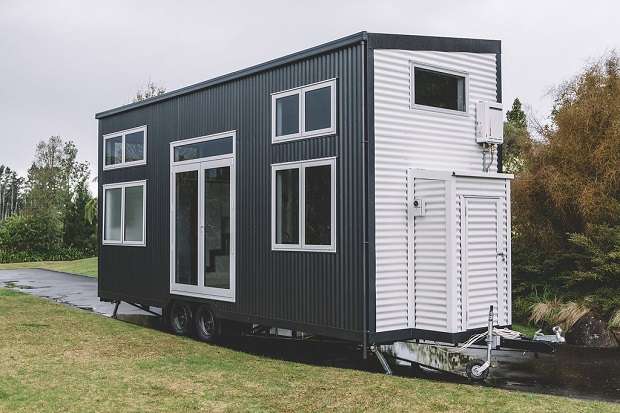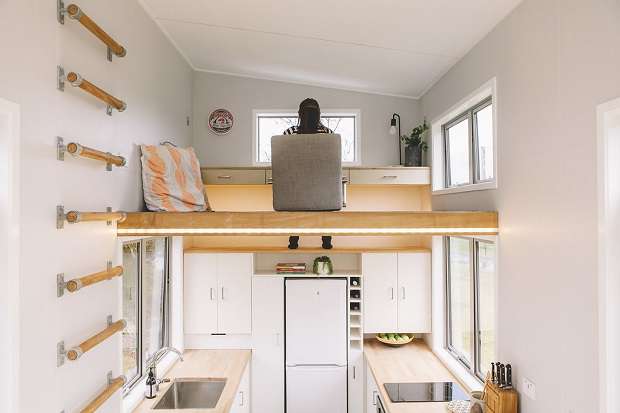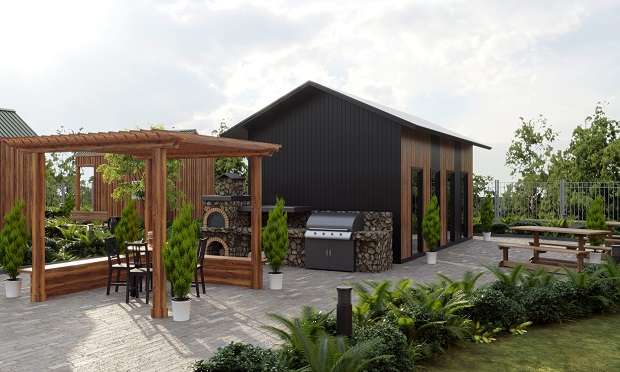In the past six weeks, the definition – and importance – of home has radically changed.
And likely, the sorts of homes we live in will change with that.
In China, companies are 3D printing c miniature isolation pod homes for hospital workers and those taking refuge from the spread of Covid-19. In Seattle, Washington, USA tiny home communities for low-income or homeless people have been has fast-tracked to allow them to safely shelter in place.
So it’s not surprising that tiny homes manufacturers around New Zealand, have seen an uptick in enquiries. Both first home buyers and people who already own homes but need more space are clamouring for bubbles of their own.
Start your property search
Gina Stevens of Katikati company Build Tiny, says that in the last half of level 4 lockdown, buyers came back to the market.

Katikati's Build Tiny has seen a surge of interest for its tiny houses on wheels, including DIY enthusiasts fitting out shells. Photo / supplied
“In one day, we had three people who’d been looking a long time ago, and are now are motivated to start building.
“They say ‘I feel more secure about getting my own place’. Since lockdown, quite a few clients who were on hold are signing contracts, they are confident”, she says.
While many of Stevens’ earlier customers were looking for affordable baches, or investment property to rent out on Airbnb, at least one of the new customers is looking at it for full-time living.
Because Build Tiny builds their customised tiny houses as road-worthy vehicles, they meet NZTA vehicle WOF and registration regulations, saving navigating complex Council zoning requirements.
“Most people had the land, they already had a house on it so this is another dwelling, some have papakainga land. Less common is buyers renting a piece of land to put their tiny house on,” she says.
The BuildTiny houses have a typical finished build cost of around $145,000, and are self sufficient for water and waste. Solar power for off-grid living adds another $18,000.

Customers like Build Tiny's clever solution to creating a work-from-home space that includes proper seating and headroom. Photo / supplied
But there’s an enthusiastic customer group for a road-worthy shell for around $60,000 which they complete with their own fit out. On the Monday and Tuesday before lockdown, the five-person factory raced to complete a shell for a client, ready to complete during lockdown weeks. Stevens says a fair proportion of new enquiries has been from buyers with similar plans.
She says inner city dwellers want to get out of the city to increase their distance from others and homeowners want a home office that’s away from the main house.
Stevens, who trained in interior architecture at Victoria University, relishes little tricks to make a space work – including building an office in loft space that allows people to work at an actual desk with room for their legs (a cut out to a ledge below) - no crouching on the floor with no headroom.
West Auckland-based Cool Cabins have been building cabins for the past 18 months, offering a rent-to-own option that has brought in the first home buyers.
“We’ve just had an 18-year-old guy in Cambridge buy one for the back of his parents’ place,” says owner Simon Davies.
“For no deposit and $150 per week, people have options, they can pay off for less than the cost of rent.”

The planned tiny house community in the former Muriwai camp grounds will allow owners to install their customised homes on wheels. Photo / supplied
Finance is arranged through banks or mortgage brokers.
The company builds to what is known as a multi-proof consent, meaning it meets national building codes, but Davies says that there are still different rules about use of land in different council jurisdictions.
On Auckland's North Shore, Sanders Cabins, better known for cute timber back yard sheds and studios, launched a Podular tiny house system in November 2019.
The modular housing pods, which connect together, are made in a factory and delivered on site, consented and ready for code of compliance once connected to services.
Owner Charles Innes says that there’s definitely been a surge of interest.
“It’s a hot topic when people are locked away and getting sick of each other, they’re wanting to find space.
“A couple of orders were put on hold until the buyers knew what was happening. But now they have certainty, all of a sudden they’ve come back. The last four or five days has really increased.”
Innes says his first tiny house customers were looking to make room for grown up kids, and found the transportable modular house was an easier solution than costly alterations to their existing house.
Now lockdown enquiries are from young people who’d come back to New Zealand, wanting to put their Podular modular dwelling on parents’ land while they save for their own property. Property investors are also adding the tiny homes to existing properties to increase their rental yield.
Innes says first home buyers have used their Home Start loans to buy a bit of land and install their house. Some who have been priced out of Auckland are buying land in Northland for their tiny home, renting in the city and spending weekends on their country property.
Most buyers start with a 40 to 50 square metre tiny house, Innes says, which can be factory-built in five or six weeks.
In February, OneRoof revealed details of New Zealand’s first tiny house village for 18 homes, slated to open in the former campgrounds in Muriwai late this year.








































































